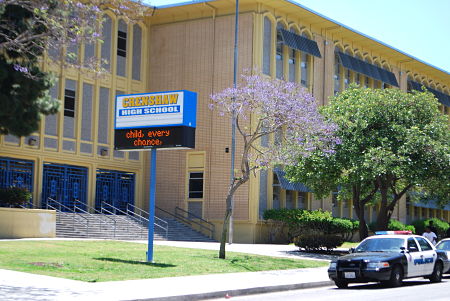 LAUSD Superintendent John Deasy’s letter, dated October 23, 2012, ordered Crenshaw Senior High School to come under the direct supervision of LAUSD’s Intensive Support and Innovation Center, “effective immediately.” Citing “four years of…less than adequate progress in….several key indicators,” Deasy informed the school that it would be divided into three magnet schools with increased AP courses and International Baccalaureate pathways. All teachers and administrative staff would have to reapply for the school’s relaunch on July 1, 2013.
LAUSD Superintendent John Deasy’s letter, dated October 23, 2012, ordered Crenshaw Senior High School to come under the direct supervision of LAUSD’s Intensive Support and Innovation Center, “effective immediately.” Citing “four years of…less than adequate progress in….several key indicators,” Deasy informed the school that it would be divided into three magnet schools with increased AP courses and International Baccalaureate pathways. All teachers and administrative staff would have to reapply for the school’s relaunch on July 1, 2013.
Sylvia Rousseau, former interim principal at Crenshaw High and now a professor in USC’s Rossier School of Education, says the Superintendent has a point. “Clearly, it has to be acknowledged that the school has not performed at the level that it needs to perform,” said Rousseau.
A program called Extended Cultural Learning was partially implemented at Crenshaw in 2011-2012, after some disappointing results on state tests in preceding years. Since implementation, proponents say the school has met or exceeded all of California’s Academic Performance Index targets for growth except one.
Based on those results, Crenshaw successfully applied for the highly competitive School Improvement Grant, or SIG, from the Federal Department of Education and administered through the State of California. Half of all SIG applications from California were rejected. Crenshaw received $6 million dollars to continue improvements at the school. That award may be in jeopardy if the school is significantly restructured.
Furthermore, says educational scholar John Rogers of UCLA, there’s just not a lot of research supporting reconstitution. “Paradoxically, despite the fact that the federal government increasingly calls for research-based reform, there really isn’t a research base for reconstitution.” said Rogers.
Why then is reconstitution becoming increasingly popular—according to one study, up to 60 percent from 10 years earlier? “I think education reform often is driven by a desire for quick & simple & often cheap answers,” said Rogers. “Lots of people are frustrated with the slow pace of reform or by schools that are not enabling young people to achieve the goals the young people have & their communities have.”
But as Rousseau underlines, a large body of data says that kids in under-performing urban schools often don’t see the relevance of education to their lives unless it has positive effects in the surrounding community. “So the students saw the relevance and the importance between education and their own capacity to make change in their community,” she said.
And Crenshaw did this through Extended Cultural Learning. That will be replaced by three magnet schools under Deasy’s proposed revamp. Rousseau says if funding isn’t stabilized, if personnel aren’t stabilized, progress will be hard to hold on to. “Unless the district takes a comprehensive view of the needs of the students, unless we take a more humanistic approach that our students aren’t widget,” she said.
Deasy and Crenshaw High faculty and staff are due to meet after the Thanksgiving holiday. It’s not clear if reconstitution is a done deal, or if there’s still room for negotiation.














